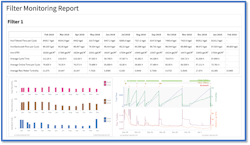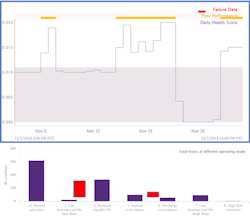Advanced Analytics Applications Enhance Municipal Asset Management
Every water and wastewater system is a collection of assets installed to work as a unit, including pipes, valves, tanks, pumps, treatment facilities, control system components, and others.
As systems age and deteriorate over time, these assets lose value and require maintenance to continue efficient operation. To effectively manage this maintenance, the software behind control systems and operational analysis must keep pace with the ever-increasing volumes of operational and maintenance data.
Without asset management models and equipment maintenance programs in place, municipalities frequently face unexpected and excessive repair costs. But modern advanced analytics software empowers these utilities to make informed maintenance decisions by leveraging operational and component-specific data to determine ideal times for repairs, replacements, and retrofits. This reduces operating costs and downtime, enabling more sustainable and efficient operations.
Manual Tracking Challenges
Given the responsibilities to supply clean and affordable drinking water — often at fractions of pennies per gallon — to safely dispose of wastewater, and ensure sustainable yield into the future, water districts and municipalities have a full plate. To improve operations and ensure goals are met, municipalities have embraced automated tools such as supervisory control and data acquisition (SCADA) systems, but effectively keeping track of assets remains a challenge.
Without asset maintenance programs in place, it is easy to fall behind, constantly reacting to the next component failure. Some utilities attempt to manually track asset installation, repair, and condition assessment data using spreadsheets, but cumbersome manual procedures, along with software or formatting incompatibilities, typically cause problems.
When relying on manual methods, subject matter experts (SMEs) can spend days or weeks conditioning, verifying, and contextualizing equipment data. These challenges become more serious as data volume grows (Figure 1), simultaneously increasing in granularity and complexity, and eventually spreadsheet tracking must give way to a more robust solution.
Seeq helped the municipality’s engineers make long-term improvements by eliminating the monthly spreadsheet reporting workload, and by increasing filter performance and operational consistency, in addition to increasing the production-to-backwash ratio across filters. Manual reporting time was reduced from 20 hours per month to less than one hour.
This near real-time application of best practice guidelines enabled operators to quickly identify problem filters by upgrading maintenance from scheduled-based to performance-based.
Advanced Analytics Applications for Asset Management
Advanced analytics software provides a comprehensive solution for managing predictive models by using input parameters from multiple disparate data storage systems. As a cloud-hosted application, it accomplishes this by connecting to existing data silos and multiple data sources without copying or duplicating any data from source systems. Using automated cleansing and easy-to-implement calculations and data contextualization, SMEs can quickly perform diagnostic, predictive, and descriptive analytics on time series process data.
This data often includes noise, small spikes, and erroneous values, complicating analyses, but with cleansing methods—such as smoothing filters—this noise can be greatly reduced, enabling much simpler contextualization. In addition to signal smoothing, SMEs can leverage outlier removal and time shifting, which are methods for ignoring irrelevant data that may have been created, for example, when an asset was out of service. By using these tools, SMEs no longer need to waste time sorting through spreadsheets and manually wrangling data, providing them with greater opportunities to analyze patterns and models that lead to useful insights.
Equipped with real-time collaboration and knowledge sharing capabilities, advanced analytics applications empower engineers and data scientists to easily share insights across teams and sites, ultimately accelerating communication throughout an organization. This enables teams to develop holistic asset management strategies that include:
- A deeper understanding of existing data;
- Identification of existing asset inventory and critical assets;
- Service planning and life cycle cost estimating to manage aging infrastructure; and
- Capital planning and funding based on forecasting and predictive maintenance.
As the water industry examines asset management, predictive analytics, and data science solutions, collaborative methods are critical to success. Advanced analytics solutions help engineering teams connect to data, and then create and share insights throughout the organization, increasing maintenance program, business process, and operational production efficiency.
Example: Sand Filter Asset Management & Reporting
Water filtration plants face several competing priorities, including minimizing costs, complying with regulations, and improving internal reporting for better future decision-making.A water agency looking to improve its sand filter consistency and improve performance of its fleet of filters throughout the water treatment plant required a method to identify poor performance and prioritize maintenance. Simultaneously, it sought to minimize clean water usage in the filter backwash process.
The operations team used a large, complex spreadsheet developed years ago to track filter performance. The team was particularly interested in backwash cycles, which require seasonal changes to the allowable run time between backwashes and the backwash rates, and in comparing performance to identify mechanical problems and filter replacement requirements.
Using Seeq, an advanced analytics application, the agency’s engineers created a filter analysis model, enabling operators to contextualize data using operating mode conditions. They then developed monitoring metrics, such as unit filter run volume, and quantified the costs of each backwash. With this information in hand, it was easy to visualize each backwash cycle overlaid on subsequent cycles, and to compare these results to other filters.
After deployment of this model throughout the filter fleet using asset structures, the team can now track filter and backwash efficiency in near real-time, and then examine automatically-updated daily and monthly reporting dashboards (Figure 2). This increased production uptime by helping the operations team monitor and identify filter issues prior to failure, enabling them to make appropriate operational adjustments and perform required maintenance.
Seeq helped the municipality’s engineers make long-term improvements by eliminating the monthly spreadsheet reporting workload, and by increasing filter performance and operational consistency, in addition to increasing the production-to-backwash ratio across filters. Manual reporting time was reduced from 20 hours per month to less than one hour.
This near real-time application of best practice guidelines enabled operators to quickly identify problem filters by upgrading maintenance from scheduled-based to performance-based.
Example: Pump Health Monitoring
Municipality maintenance practices often lack the detail required to characterize pump performance and anticipate asset health in near real-time. This results in schedule-based preventive maintenance and often unnecessary work, while reactive maintenance produces unplanned downtime.
These daily reports reduced pump failure occurrences, resulting in lower overall maintenance costs and increased uptime.
Easing Asset Management Pain
Plagued by outdated asset management practices or the lack thereof, an increasing number of municipalities are deploying advanced analytics software to effectively model, monitor, and manage their assets.
This provides process improvement and faster troubleshooting, while enabling predictive maintenance. Using this software, plant personnel can now easily and collaboratively produce analyses that tell stories, empowering teams to make well-informed operational and maintenance decisions, and to track and efficiently maintain their assets for long-lasting value.
Cloud-hosted advanced analytics application like these are poised to help SMEs in the water and wastewater sector drive their data analytic and asset management methodologies into modern times. Advanced analytics software is enabling agencies to connect to many types of data sources and transform information into insights for increased process efficiency, empowering them to deliver high-quality service to the public.
About the Author
Giro Iuliano
Industry Principal
Giro Iuliano is an industry principal at Seeq Corporation. He brings nearly 20 years of sales and business development experience to Seeq, following a decade working with power and utilities customers at OSIsoft, and five plus years at Oracle and Itron. Iuliano holds a bachelor’s degree in electrical engineering from Northeastern University.



